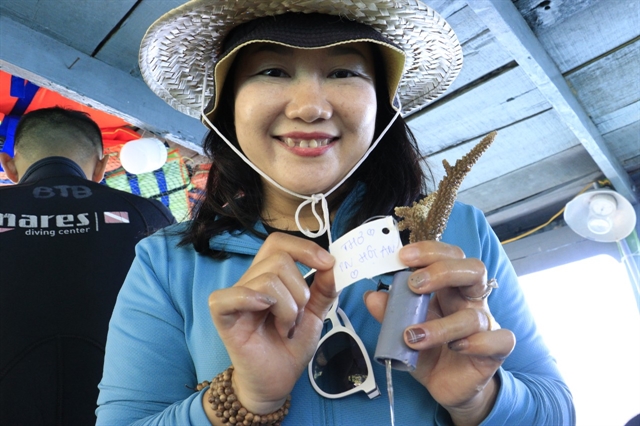
ALL SMILES: A visitor prepares a coral branch to be replanted at a coral restoration site in the water off Chàm Islands. VNS Photo Công Thành
By Bùi Hoài Nam
The glistening turquoise waters off the Chàm Islands provide an ideal option for beachgoers in summer, but it’s a tough time for Huỳnh Ngọc Diên and other members of the coral restoration team at the Chàm Island Maritime Protected Area (MPA) as they rush to fix coral tentacles on sea bed during the best weather of the year.
The team only has a few months to anchor the coral graft frames at the bottom – where more new coral tentacles will grow into a larger population of corals for the protection of the beach from strong waves and erosion in storm season.
“We have to work in shifts, as scuba divers are soon exhausted with water pressure at 10m or 15m deep. It is difficult to keep balance in the deep strong flows while fastening every coral branch with screws on fixed frames at the sea bottom,” Diên says.
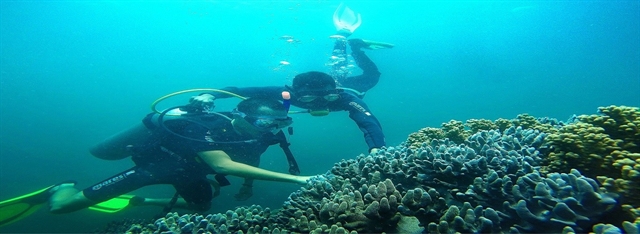
DEEP BLUE SEA: Two divers check a coral reef in the water off Chàm Islands following an annual coral survey and protection. Some 356ha of coral reefs at different sites around the islands have been conserved and restored. Photo courtesy of Chàm Islands MPA
“All members of the team have kept a working schedule for years in setting up thousands of coral clusters in the water off the Chàm Islands and surrounding islets. We select liveable tentacles from already grown coral reefs to expand the wider coral population.”
Diên, who was born on the Islands, says the fixed frame coral restoration has been an effective solution in reviving coral complexes off the Chàm Islands for decades.
Trần Thị Phương Thảo, a member of the team, says time is needed for her to recover power after hours of breathing with scuba equipment in the deep water.
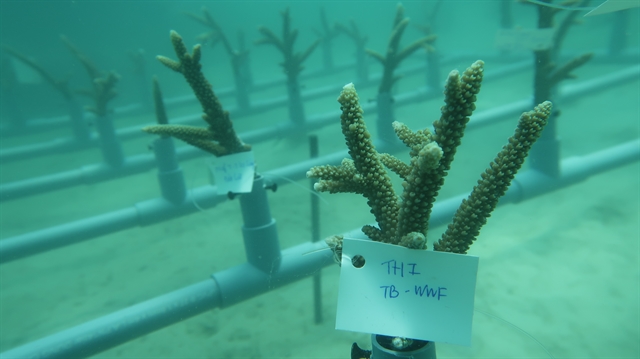
RESTORATIVE: Branches of coral are fixed on an anchored frame at the sea bed in the water off the Chàm Islands. The restoration of the coral population creates a safe shelter for aquatic species and seafood resources. Photo courtesy of Chàm Islands MPA
She says the work was not usually smooth, as rough waves could happen at any time in a day to prevent diving.
“It needs strong power and skilful hands when fixing coral branches on frames – where young corals will find a stable base for growing. We design frames in a strong structure for fixing coral branches on it,” Diên says.
He explained the coral restoration solution ensures the existence of young coral tentacles in a safe flow area while limiting the damage by the rough sea.
Coral recovery
As a result, more than 40 coral nurseries and two restoration areas of a total 8,000sq.m have been planted to fill in the damaged coral reefs off Chàm Islands, achieving a survival ratio of 80 per cent, according to a report from MPA.
About 356ha of coral reefs – a 200 per cent increase – have been restored and protected since 2006, says Director of the MPA Trần Thị Hồng Thúy.
“The MPA management board had built up an effective integrated management and conservation including degraded forest recovery, raising awareness among the community on the importance of environment protection, promoting responsible tourism as the livelihood base of nature conservation,” Thúy says.
“Almost all Chàm islanders are aware of natural conservation activities, and the programmes that the MPA has been carrying out over past decades as well.”
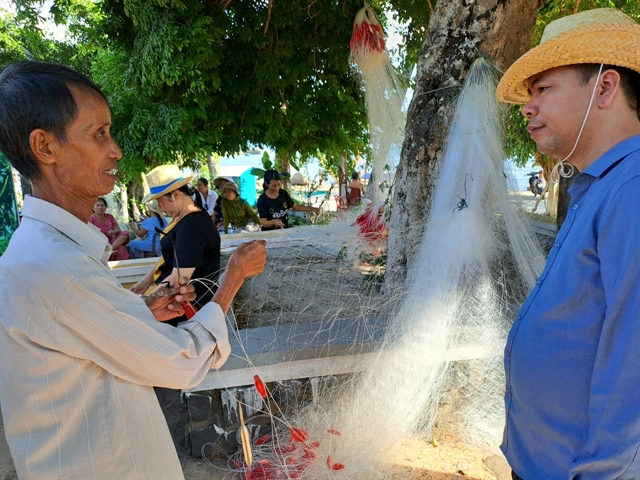
COASTAL TOUR: Trần Hoàn, a local fisherman (left), introduces fishing net weaving to a tourist. Eco-tour services and community-based tourism have helped build sustainable growth on the islands. VNS Photo Công Thành
The coral population off the beaches of Lá, Dài, Bãi Bắc, Bãi Nần and Bãi Tra are regarded as the best sites, with 300 coral species conserved or newly restored since 2006.
According to the MPA, the coral reef protected sites have reached an average coverage of 8 to 40 per cent, and have naturally developed as a safe shelter for fish species, creating a sustainable source of seafood for the fishing community on the islands as well as a favourite environment for eco-tourism growth.
Lê Vĩnh Thuận, deputy director of the MPA, explains that good environmental protection and pollution control by the islands’ authorities and people have helped speed up the restoration work.
Nguyễn Văn Long, an expert from the Institute of Oceanography, says the coral population of the Chàm Islands has a rich biodiversity, and was well conserved after decades of protection.
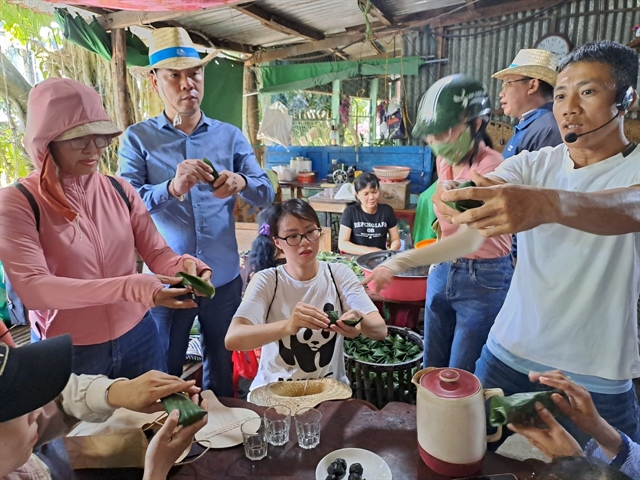
PIECE OF CAKE: Tourists are guided on how to make a traditional cake on the Chàm Islands, off the coast of Hội An. VNS Photo Công Thành
The restoration of the coral and ecological system has helped build the islands as a typical symbol of successful nature conservation through active management programmes and the gentle manners of local islanders since it was recognised as a world biosphere reserve site in 2009.
The rapid development of the coral reefs has aided the reproduction of fishes and other aquatic species while protecting the islands’ beaches from erosion and damage from natural disasters, says local fisherman Trần Hoàn.
“All of us use bigger mesh nets, and we have stopped fishing in the restricted zones and times. We now eye the quality of the catch rather than the quantity. Big fish sell at a higher price than small ones,” he says.
“The fishing community now enjoys ‘slow living' and high-value fishing in sharing habitat space for aquatic and forest species in peaceful co-existence. The ‘no fishing zone’ and off-fishing season are strictly followed by local fishermen.”
Cao Thị Phương of a family-owned seafood processing business says that the protected coral reefs have provided shelter for all aquatic species and become high-value seafood resources.
“It’s the reason islanders and the fishing community join hands with the MPA in protecting the marine environment and curbing pollution,” Phương says.
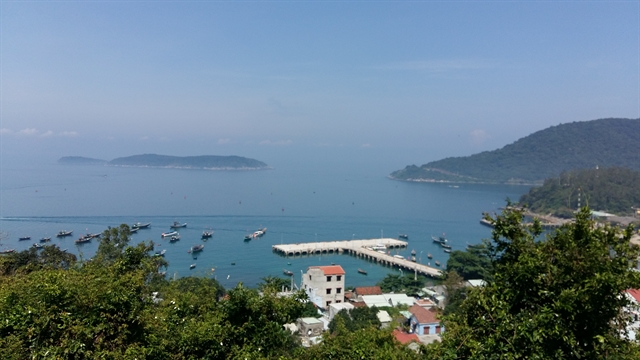
ALL AT SEA: A view of Chàm Islands' cruise dock from the mountain. The Islands lure tourists with pristine landscapes and well-conserved nature and culture. VNS Photo Công Thành
“Our family’s half-dried squid earned OCOP (One Commune One Priority Product) recognition as an eco-tour product after 10 years in the business. We set up a partnership with 25 fishing boat owners to promote the production sustainably,” she says.
The businesswoman says the community-based eco-tourism and seafood production have helped local people diversify their livelihoods.
“The fishermen on the islands now make shorter sea trips but for a higher price catch and a sustainable income. Their families also provide homestay service for tourists,” she says.
The Chàm islands and Hội An region is a favourite destination in Việt Nam, assigning a limit of no more than 3,000 visitors each day to reduce pressure on the marine ecosystem.
The islands are the only destination in the country with a ‘Say No” to plastic bags scheme, and are also on their way to becoming a ‘zero waste’ and ‘zero plastic waste’ site.
In promoting the value of rich biodiversity, the Chàm Islands has been preparing for the establishment of the Chàm Islands Nature Reserve for the expanded protection and conservation of natural resources of 23,500ha of land and sea.
“We’ll keep conserving the islands as the best-protected reserve in terms of marine and forest environment, unique cultural value, and with communities very much aware of their human and wildlife habitat in Việt Nam,” Diên says. VNS
OVietnam